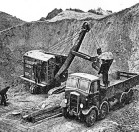Formby Sand Extraction History

John Houston – July 2007
This is an invitation to all members to help with a local history project.
You have to be quite a detective these days to notice the signs left by sand quarrying at Formby Point. But in fact much the landscape was worked for sand last Century leaving cliffs and spoil dumps, track-ways and ponds. Joan Rimmer in the Village That Was Formby tells how Noel Woodward started his business by taking sand from the Formby Sandhills in the 1920s. Until the 1950s Woodward’s company excavated thousands of tons of sand from several sites at Lifeboat Road, Ravenmeols Sandhills and Range Lane.
We now have a unique opportunity to find out more about this part of our heritage thanks to a project funded by Natural England and coordinated through the Sefton Coast and Countryside Service. And we are looking for help from Civic Society members in helping to research the Formby Times archives, in digging out old photographs and in telling us what you know about the works, the people involved, the sand-pits in which you played and the local names for the quarries. At the end of the project we hope to have learned much more about this part of our history, produced a booklet and leaflet and helped to prepare an interpretive sign to go up alongside the coastal footpath at Lifeboat Road. The Coast and Countryside Service will arrange guided walks and will use the information we collect in their education programmes.
The Project is advised by Dr Jen Lewis, chair of the Sefton Coast Partnership History and Archaeology Group. Alan Crosby, an historical geographer, will lead on the search of official archive material at the Lancashire Records Office and we hope that he will be able to present his results to the History Group later in the year.
Specialists, including Jen Lewis and Dr Phil Smith will make their assessments of the archaeology, wildlife value and geological value (e.g. for education) of the sand works. To round off the study, in March next year we hope to use one of the general meetings to present the results of the project with computer-generated mock-ups of different options for habitat creation in some of the sites.
We will give more about the history of sand extraction in the next newsletter. But, for now, we need volunteers from the Society to help search the Formby Times archive, our own material and to spread the word about the project by talking to older people who know about the works. We will have access to a modern recorder (MP3 player) to help with oral history.
To get involved in the project please contact Barbara Yorke on 01704 872187 or John Houston on 01704 870455. We hope to start work searching the archives in September.
Now for the credits. The project has been made possible by a grant from Natural England through Defra’s Aggregates Levy Sustainability Fund. In simple terms all present-day extraction of aggregates from quarries has to pay a levy to the Government to be used for social and environment projects which offset some of the problems caused by the industry. Here we are using a small grant for a research project linked to local history. The grant has been given to Sefton Council who will guide the work and submit all the grant claims. The project involves Sefton Coast and Countryside Service, Sefton Council Coast Defence Team, Sefton Coast Partnership, Formby Civic Society and Lancashire Wildlife Trust.
